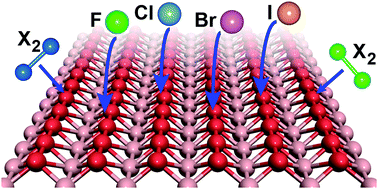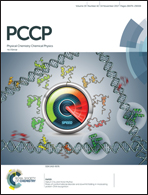The interaction of halogen atoms and molecules with borophene†
Abstract
The realization of buckled monolayer sheets of boron (i.e., borophene) and its other polymorphs has attracted significant interest in the field of two-dimensional systems. Motivated by borophene's tendency to donate electrons, we analyzed the interaction of single halogen atoms (F, Cl, Br, I) with borophene. The possible adsorption sites are tested and the top of the boron atom is found as the ground state configuration. The nature of bonding and strong chemical interaction is revealed by using projected density of states and charge difference analysis. The migration of single halogen atoms on the surface of borophene is analyzed and high diffusion barriers that decrease with atomic size are obtained. The metallicity of borophene is preserved upon adsorption but anisotropy in electrical conductivity is altered. The variation of adsorption and formation energy, interatomic distance, charge transfer, diffusion barriers, and bonding character with the type of halogen atom are explored and trends are revealed. Lastly, the adsorption of halogen molecules (F2, Cl2, Br2, I2), including the possibility of dissociation, is studied. The obtained results are not only substantial for fundamental understanding of halogenated derivatives of borophene, but also are useful for near future technological applications.



 Please wait while we load your content...
Please wait while we load your content...